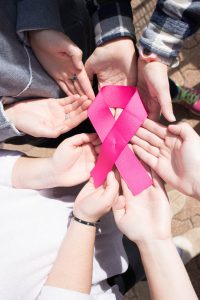Kim Harms
News editor
kharms3@jccc.edu
There are so many images in my mind when I picture the month of October. I think of the changing leaves, pumpkin patches, haunted houses and the color pink. Growing up as the daughter of a breast cancer survivor, October holds a special place in my heart.
I remember past years during October, races, auctions and shopping events were held every weekend to honor Breast Cancer Awareness Month. I noticed this year is slightly different. The only major events I found were the annual Race for the Cure hosted by the Susan G. Komen foundation and the Making Strides Against Breast Cancer walk hosted by the American Cancer Society. I hoped after several Google searches I would find a smaller event, where the proceeds go to a local organization rather than a national one. Unfortunately, my searches came up short.
The lack of events and lack of pink this month in the local area is alarming. Breast cancer is one of the most common forms of cancers. The Susan G. Komen website says 1 in 8 women will develop breast cancer at some point in their lifetime. Men are not immune either because 1 in 1,000 men will develop breast cancer in their lifetime. With the chances of developing breast cancer so high, awareness is the best option in order to start taking action.
Breast Cancer Awareness Month, to me, means sharing information so women are fully aware of their risk and early preventative steps. Teaching women about their risk is important because each woman has a different risk. For example, women who are active everyday have a smaller risk than women who are active once or twice a week.

One of the biggest risk factors women may have is a first-degree relative with breast cancer. Women who have a mother, sister or daughter with breast cancer, their risk is 50 percent higher. If you have not had breast cancer yourself, then you more than likely know someone close to you who has and your risk could potentially be higher. My risk is automatically 50 percent higher because my mother had breast cancer seven years ago.
Teaching women about early detection and prevention is important too. Once women know their risk, they need to know how to take action. The most efficient way to detect breast cancer is through mammograms. The general age to begin mammograms is 40, however, women with an increased risk may begin earlier. If women or men are at increased risk because of their weight, smoking or drinking, they need to be aware of how they can greatly lower their risk through a few lifestyle changes.
With all of the information I have provided, I ask that it be shared. Wear pink this week and share with friends, colleagues and family why they should wear pink as well. Tell them the risk factors and what they can do to lower their risk. Learn more information by visiting the Susan G. Komen website and share that information with others. Sign up for the Making Strides Against Breast Cancer walk this Saturday to share support with hundreds of men and women who are affected by breast cancer. Make a difference by donating to the American Cancer Society, every donation helps someone who is currently getting treatment for breast cancer. Be aware, share your awareness and be the support for those who are already battling breast cancer.






















